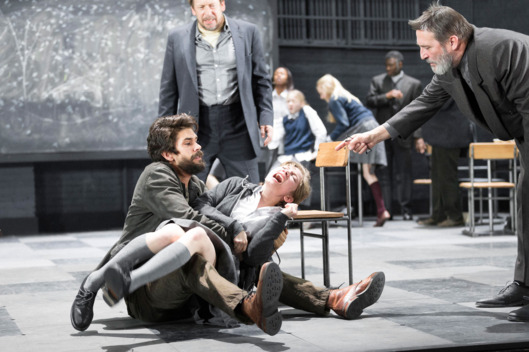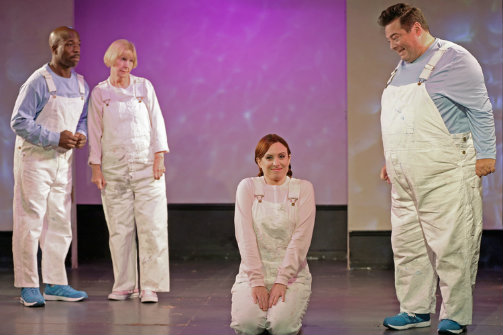by Carol Rocamora
An icy wind is blowing through the Walter Kerr Theatre, bringing with it Ivo van Hove’s merciless and frightening new interpretation of The Crucible, the American classic we thought we knew so well.
Set amidst the Massachusetts witch trials of the late 17th century, Arthur Miller wrote his allegorical play in 1953 to express his outrage about the McCarthy hearings, that infamous modern-day hunt for Communists that sent a rash of paranoia throughout the Hollywood community (not to mention the country). The advent of this revival—in our current era of fear for enemies unseen and unknown—couldn’t be more timely.
Director Ivo Van Hove has assembled a stellar international cast to tell the story of troubled Salem, Massachusetts in 1692. A group of young village girls have been discovered dancing naked in the woods at night. To divert blame, they insist (under their cunning leader, Abigail) that they have been possessed by the devil. A witch-hunt is organized, supervised by Deputy Governor Danforth, resulting in a frenzied epidemic of “naming of names” by the girls, who accuse dozens of other villagers of cavorting with the devil. The community is thrown into a political and moral crisis that threatens to end in the death of many innocent citizens.
Meanwhile, Abigail has another motive. She had served as a housemaid for the Proctors, a farming family, and had a passionate affair with the husband (John), who now rejects her. Elizabeth, his wife, fired Abigail, who now seeks revenge, and names her former mistress as one of the possessed, too. John faces the choice to reveal his adultery in an attempt to save his wife, or be silent and save himself.
Van Hove, a daring Dutch director known for radically deconstructing the classics, has stripped Arthur Miller’s play bare, along with the Walter Kerr stage. His ensemble plays out this terrible story in a bleak, empty space that looks more like a rehearsal room. Van Hove and Jan Versweyveld (his scenic and lighting designer) are known for their unconventional choices – and here is no exception. The back walls are bare, save for a large blackboard that serves as a schoolroom prop, or a backdrop of a village landscape, scrawled with a few lines of chalk. The overhead lighting is neon, and the furniture pieces are stacked on the sides and in corners. This empty space serves alternately as a schoolroom, the Proctor’s household, and the trial room, with the actors moving a few chairs to represent the changes. Wojciech Dziedzic’s costumes are deliberately drab and generic. The result is severe, stark mis-en-scène where the wrenching events of the play take place.
Van Hove’s casting is equally unconventional. John Proctor, usually performed by actors of tall stature (Daniel Day Lewis, Liam Neeson), is played here by Ben Whishaw, a slight, sensitive actor known for his delicate portrayals of Hamlet, Sebastian Flyte (Brideshead Revisited), and Shakespeare’s Richard II. He infuses his Proctor with an intensity, honesty, and moral backbone that render his stature as great as his predecessors’. Elizabeth is played by Sophie Okonedo, an Afro-English actress of stage and screen known for her charismatic presence and fortitude. Together, they generate a heartbreaking portrait of a marriage in life-and-death crisis. Ciarán Hinds is appropriately fiery as the “hanging judge”, and Bill Camp plays John Hale (a sympathetic Reverend) with humanity. Saoirse Ronan (seen recently in Brooklyn) plays a riveting Abigail, whose pale face radiates with an evil resolve bordering on madness.
Several times during this gripping production, a broad black curtain rises and then abruptly falls – once, to reveal a class of innocent young school girls, and later to reveal one of them suddenly flying in mid- air. At the top of act two, this ominous black curtain rises to reveal a huge live wolf prowling around the stage! Underscored by Philip Glass’s strange, hypnotic musical score, these frightening moments build to a cumulative terrifying effect. To top it all, van Hove stages a stunning coup de théâtre when the girls enact their final vision – one that (literally) blows the audience away.
No opportunity has escaped this director’s stern, steely eye. Could van Hove be that wolf who has been prowling around American stages over the past decade, showing us visions we don’t want to see?
Arthur Miller’s The Crucible. Through July 17 at the Walter Kerr Theatre (219 West 48th Street, between Sixth Avenue and Broadway). www.thecrucibleonbroadway.com
Photos: Jan Versweyveld

























